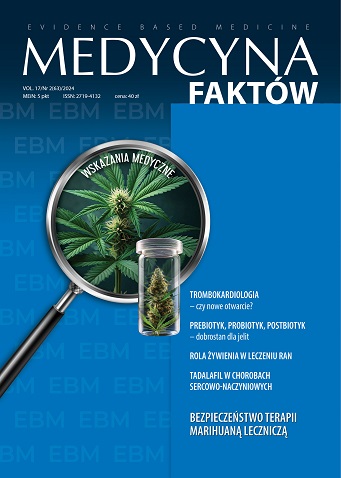Heartburn – what, when and how to relieve it? Review article
Main Article Content
Abstract
One of the symptoms most frequently reported in doctor’s offices is heartburn, which is defined as a burning sensation along the esophagus. It is also the main symptom of gastroesophageal reflux disease, but it may also appear incidentally. Depending on the frequency of symptoms, their duration and severity, different procedures are proposed, which are aimed at quickly relieving heartburn, healing potential inflammatory lesions of the esophagus or temporarily eliminating the burning sensation in the esophagus if it does not occur frequently or constantly, but only in specific situations. e.g. after dietary mistakes. Patients’ self-treatment should be limited to 2 weeks, and in case of the slightest doubt or the occurrence of alarm symptoms, diagnostics should always be in-depth with additional tests. Treatment with proton pump inhibitors should be limited to 4–8 weeks, and in case of failure, the patient should also be referred to a specialist. Acute use of famotidine, alkinates, and alginates may be effective for episodic symptoms.
Article Details
Copyright © by Medical Education. All rights reserved.
References
2. Ziółkowski BA, Pacholec A, Kudlicka M et al. Epidemiologia dolegliwości brzusznych w polskiej populacji. Prz Gastroenterol. 2012; 7(1): 20-5.
3. Gyawali CP, Yadlapati R, Fass R et al. Update to the modern diagnosis of GERD: the Lyon Consensus 2.0. Gut. 2024; 73: 361-71.
4. Lipiński M. Różne oblicza choroby refluksowej przełyku wymuszają indywidualne podejście do pacjenta. Czym dysponujemy? Lekarz POZ. 2020; 4: 187-95.
5. Waśko-Czopnik D. 10 faktów na temat famotydyny. Medycyna Faktów. 2022; 2(55): 137-40.
6. Waśko-Czopnik D. 4 profile pacjentów, w leczeniu których wybieram famotydynę. Medycyna Faktów. 2023; 1(58): 43-5.
7. Gąsiorowska A. Jak kontrolować objawy nocne u pacjentów z chorobą refluksową przełyku? Medycyna Faktów. 2024; 1(62): 115-8.
8. Gąsiorowska A, Janiak M, Waśko-Czopnik D et al. Postępowanie u pacjentów z objawami choroby refluksowej przełyku – rekomendacje dla lekarzy rodzinnych. Lekarz POZ. 2019; 5: 245-65.
9. Świdnicka-Siergiejko A, Marek T, Waśko-Czopnik D et al. Postępowanie diagnostyczno-terapeutyczne w chorobie refluksowej przełyku. Konsensus Polskiego Towarzystwa Gastroenterologii 2022. Med Prakt. 2022; 6: 38-74.
10. Yadlapati R, DeLay K. Proton pump inhibitor-refractory gastroesophageal reflux disease. Med Clin North Am. 2019; 103: 15-27.
11. Hsu PI, Lu CL, Wu DC et al. Eight weeks of esomeprazole therapy reduces symptom relapse, compared with 4 weeks, in patients with Los Angeles grade A or B erosive esophagitis. Clin Gastroenterol Hepatol. 2015; 13: 859-866.e1.
12. Wolfe MM, Sachs G. Acid suppression: optimizing therapy for gastroduodenal ulcer healing, gastroesophageal reflux disease, and stress-related erosive syndrome. Gastroenterology. 2000; 118: S9-S31.

